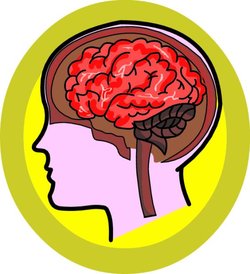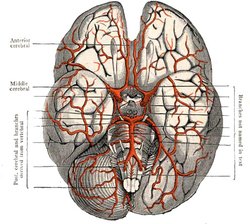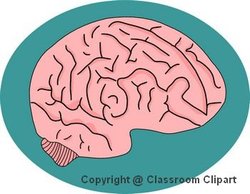Brain
|
|
In the anatomy of animals, the brain, or encephalon, is the supervisory center of the nervous system. Although the brain is usually cited as the supervisory center of vertebrate nervous systems, the same term can also be used for the invertebrate central nervous system. In most animals, the brain is located in the head.
The brain controls and coordinates most movement, behavior and homeostatic body functions such as heartbeat, blood pressure, fluid balance and body temperature. Functions of the brain are responsible for cognition, emotion, memory, motor learning and other sorts of learning.
The brain is primarily made up of two types of cells: glia and neurons. Glia function primarily to support and protect the neurons. The neurons carry information in the form of electrical pulses known as action potentials. They communicate with other neurons in the brain and throughout the body by sending various chemicals called neurotransmitters across gaps known as synapses. Small invertebrates such as insects may have a million neurons in the brain, larger vertebrate brains have over one hundred billion neurons. The human brain is particularly complex and enlarged.
| Contents |
A smart device
Brains in nature
Although many classes of animals have nervous systems, three groups of animals, with some exceptions, have notably complex brains: the arthropods (for example, insects and crustaceans), the cephalopods (octopuses, squid, and similar mollusks), and craniates (vertebrates and their cousins). The brains of arthropods and cephalopods arise from twin parallel nerve cords that extend through the body of the animal. The arthropod brain consists of large optical lobes behind each eye for visual processing and a central brain with three divisions. The cephalopod brain has a central group of lobes known as circumesophageal lobes that are flanked by two large optical lobes on the left and right (Butler, 2000).
The brains of craniates develop from the anterior section of a single dorsal nerve cord, which later becomes the spinal cord. In craniates, the brain is protected by the bones of the skull. Vertebrates are characterized by increasing complexity in the cerebral cortex as one moves up the phylogenetic and evolutionary tree. Primitive vertebrates, like fish, reptiles, and amphibians have cortices with less than six layers of neurons, a structure known as allocortex (Martin, 1996). More complex vertebrates like mammals have developed six-layered neocortex in addition to having some parts of the brain that are allocortex (Martin, 1996). In mammals, increasing convolutions of the brain, called gyri, are characteristic of animals with more advanced brains. These convolutions evolved to provide more surface area for a greater number of neurons while keeping the volume of the brain compact enough to fit inside the skull.
Brains in medicine
The brain, along with the heart, is one of the two most important organs in the human body. Loss of function in this organ fufills some definitions of death. Injuries to the brain tend to affect large areas of the brain, sometimes causing major deficits in intelligence, memory and control of the body. Head trauma, caused by automobile accidents or other blows to the skull, is a leading cause of death. Often in these cases, more damage is caused by swelling, or edema, than by the impact itself. Stroke, caused by blockage of blood vessels in the brain, is another major cause of death and brain damage.
Other problems in the brain can be more accurately classified as diseases rather than injuries. Neurodegenerative diseases, such as Alzheimer's disease, Parkinson's disease, and Huntington's disease, are caused by the gradual death of individual neurons leading to decrements in movement control, memory, and thinking abilities. Currently, only the symptoms of these diseases can be treated, but stem cell research may offer a cure. Mental illnesses, such as clinical depression, schizophrenia, bipolar disorder, and post-traumatic stress disorder, are now recognized as having a biological basis in the brain. These disease can be treated by psychiatric therapy, by drugs, or by a combination of treatments.
Some diseases that affect the brain are caused by germs. Viral or bacterial infection of the meninges, the membrane that covers the brain, can lead to meningitis. Bovine spongiform encephalopathy, also known as mad cow disease is a deadly disease among cattle and is linked to prions.
Some brain disorders are congenital. Tay-Sachs disease, Fragile X syndrome, Down syndrome, and Tourette syndrome are all linked to genetic or chromosomal errors. Malfunctions in the embryonic development of the brain can be caused by genetic factors or by drug use or disease in the mother.
Artificial brains
Computer scientists have produced computer systems called neural networks that are loosely based on the structure of neuron connections in the brain. Artificial intelligence seeks to replicate brain function (although not necessarily brain mechanisms) more exactly, but this has not yet proven successful. Creating an algorithm to mimic a biological brain is extremely difficult because the brain is not a static arrangement of circuits, but a network of vastly interconnected neurons that are constantly changing their connectivity and sensitivity. More recent work in both neuroscience and artificial intelligence models the brain using the mathematical tools of chaos theory and dynamical systems.
Interfacing brains with machines
The activity of a brain can be detected by electrodes, raising the possibility of "brain-computer interface".
The reverse path has also been demonstrated; brain implants have been used to generate artificial hearing and (crude and experimental) artificial vision for deaf and blind people, and brain pacemakers are now common to regulate brain activity in conditions such as Parkinson's disease.
Both of these avenues of research have potentially serious ethical implications.
For example, using electrodes in a brain and a remote control, researchers have been able to remotely control the movements of a rat. This offers the possibility to create an electronically-controlled biological "ratbot" that could go in dangerous places.
The study of brains
Fields of study
The brain is studied by several areas of science. Neuroscience seeks to understand the nervous system, including the brain, from a biological perspective. Psychology seeks to understand behavior and the brain. The terms neurology and psychiatry usually refer to medical applications of neuroscience and psychology, respectively. Cognitive science seeks to unify neuroscience and psychology with other fields studying the brain, such as computer science (as in Artificial intelligence, etc) and philosophy.
Methods of observation
Each method for observing activity in the brain has its advantages and drawbacks. Electrophysiology, in which wire electrodes are implanted in the brain, allows scientists to record the electrical activity of individual neurons or fields of neurons, but since it requires invasive surgery, this is a technique usually reserved for lab animals. By placing electrodes on the scalp, electroencephalography (EEG) measures brainwaves, which are the mass changes in electrical current from the cerebral cortex, but can only detect changes over large areas of the brain and very little sub-cortical activity. Functional magnetic resonance imaging (fMRI) measures changes in blood flow in the brain, but the activity of neurons is not directly measured, nor can it be distinguished whether this activity is inhibitory or excitatory. Behavioral tests can measure symptoms of disease and mental performance, but only provide indirect measurements of brain function and may not be practical in all animals. Post-mortem analyses of brains allow for the study of anatomy and protein expression patterns but can only be done after the human or animal is dead.
Myths
The following are some common myths or misconceptions about the mind and brain, perpetuated through common or urban myths, the media, and the promotion of dubious products to consumers (Sala, 1999). A number of practitioners of pseudoscience, new age philosophies, and mystical or occult practices are known to use some of these myths as a part of their belief systems. Also see popular psychology.
- Myth: The human brain is firm and grey. The fresh/living brain is actually very soft, jelly-like and deep red. They do not become firm and grey until they have been preserved with various chemicals/resins.
- Myth: Humans use only 10% or 1% of their brain. Though the brain still holds mysteries that are being studied, every part of the brain is known to have a function. A possible origin of this myth is the fact that only about 10% of the neurons in the brain are firing at any given time. However, if all of your neurons began firing at once, you would not become smarter, but instead suffer an epileptic seizure.
- Myth: Mental abilities are separated into the left and right cerebral hemispheres.
- Myth: Creativity can be easily developed using the simple brainstorming/lateral thinking techniques.
- Myth: Learning can be achieved more powerfully through subliminal techniques.
- Myth: Hypnosis can lead to perfect recall of details. Not only is this not entirely true, an incompetent or deceptive hypnotist can actually implant memories of events that never occurred.
Inside brains
Anatomy
| Human Brain |
|---|
In insects, the brain can be divided into four parts, the optical lobes, the protocerebrum, the deutocerebrum, and the tritocerebrum. The optical lobes are positioned behind each eye and process visual stimuli (Butler, 2000). The protocerebrum contains the mushroom bodies, which respond to smell, and the central body complex. The deutocerebrum includes the antennal lobes, which are similar to the mammalian olfactory bulb, and the mechanosensory neuropils which receive information from touch receptors on the head and antennae. The antennal lobes of flies and moths are quite complex.
In cephalopods, the brain is divided into two regions: the supraesophageal mass and the subesophageal mass. These parts are divided by the animal's esophagus. The super- and subesophagal masses are connected to each other on either side of the esophagus by the basal lobes and the dorsal magnocellular lobes. The large optic lobes are sometimes not considered to be part of the brain proper since the optic lobes anatomically separate from the brain and are joined to the brain by the optic stalks. However, the optic lobes perform much of the visual processing and can be functionally considered to be a part of the brain.
In vertebrates, a gross division into three major parts is used: hindbrain (medulla oblongata and metencephalon), midbrain (mesencephalon) and forebrain (diencephalon and telencephalon). Varied taxonomies have been used by assorted schools at various times in history for the study of diverse species.
An anterior part of the telencephalon called the cerebrum makes up the largest section of the mammalian brain and in humans, its surface has many deep fissures (sulci) and convolutions (gyri), giving a wrinkled appearance to the brain. In most vertebrates the metencephalon is the highest integration center in the brain, whereas in mammals this role has been adopted by the cerebrum. Behind (or in humans, below) the cerebrum is the cerebellum, a complex structure that helps in the control of movement. The cerebellum attaches to the hindbrain in a structure called the pons. The cerebrum and the cerebellum consist each of two halves (hemispheres). The corpus callosum connects the two hemispheres of the cerebrum. An outgrowth of the telencephalon called the olfactory bulb is a major structure in many animals, but in humans and other primates, it is relatively small.
Vertebrate nervous systems are distinguished by encephalization and bilateral symmetry. Encephalization refers to the tendency for more complex organisms to gain a larger-size through evolutionary time. Larger vertebrates develop a complex of layered, networked and convoluted grey matter and white matter. Grey matter refers to tissue mostly comprised of neurons and can be found on the surface of cerebral cortex, as well as in clusters called nuclei deep within the brain. White matter refers to axons and their surrounding myelin insulation, which gives this tissue its white color. White matter is found in bundles of fibers known as tracts which connect the different parts of the brain. In modern species most closely related to the first vertebrates, brains are covered with three layers of gray matter, along with gray deep brain nucleus, supported and interconnected by deep brain white matter. Most regions of the human cerebral cortex have six layers of neurons, a structure known as neocortex.
The meninges are the system of membranes that separate the skull from the brain. The three-layered covering is made of dura mater, arachnoid and pia mater. The brain is suspended in cerebrospinal fluid, which circulates between layers of the meninges and through cavities in the brain called ventricles.
Regions identified in chordate brains include:
Function
Vertebrate brains receive signals through nerves arriving from most portions of a body, interpret those signals and formulate reactions based on prior experiences and on physical needs. A similarly extensive nerve network delivers signals from a brain to control muscles throughout a body.
Sensory input is processed by the brain to recognize danger, find food, and identify potential mates, among other goals. Visual, touch, and auditory sensory pathways of vertebrates are routed to the thalamus and then to regions of the cerebral cortex that are specific to each sensory system: the visual system, the auditory system and the somatosensory system. Olfactory pathways are routed to the olfactory bulb, then to various parts of the olfactory system. Taste is routed through the brainstem and then to other portions of the gustatory system.
To control movement, the brain has several parallel systems of muscle control. The motor system controls voluntary muscle movement, aided by feedback loops in the cerebellum and the basal ganglia. Nuclei in the brainstem control many involuntary muscle functions such as heartrate and breathing.
Brains also produce hormones that can influence organs elsewhere in a body and brains react to hormones produced elsewhere in the body. In mammals, most of these hormones are released into the circulatory system by a structure called the pituitary gland.
It is hypothesized that developed brains derive consciousness from interaction among numerous systems within the brain. Cognitive processing in mammals occurs in the cerebral cortex but relies on mid-brain and limbic functions as well, especially those of the thalamus and hippocampus. Among vertebrates, sensory processing involves progressively rostral regions of the brain among newer species.
Hormones, sensory information, autonomic processes, and cognitive processes alike can exert strong influence on the regulation of brain activities. Stimulus from any source can trigger a general arousal process that decreases reliance on cortical processes, or that enhances and focuses cortical processes. Such diverse causes as hunger, fatigue, beliefs, unfamiliar information or actual threats can trigger an alert response that can exert control over cognitive priorities.
History
Ancient Greeks held differing views on the function of the brain. Hippocrates believed the brain to be the seat of intelligence, but Aristotle held that the brain was a cooling mechanism for the blood, while the heart was the seat of intelligence. Aristotle reasoned that humans are more rational than the beasts because they have a proportionally larger brain to cool their hot-bloodedness (Bear, 2001).
During the Roman Empire, the anatomist Galen dissected the brains of sheep. He concluded that since the cerebellum was hard to the touch, it must control the muscles, while since the cerebrum was soft, it must be where the senses were processed. Galen further theorized that the brain functioned by movement of fluids through the ventricles (Bear, 2001).
In the Age of Reason, Ren頄escartes espoused a fluid mechanical view of the brain similar to Galen's theories. However, Descartes thought that although this explanation was adequate to explain the brain functions of animals, the higher mental functions of humans were accomplished by the soul. This theoretical separation of the mind and brain became known as the mind-body problem (Bear, 2001).
In the mid-1600s, however, great progress in the anatomy of the brain was achieved with the works of English anatomist Thomas Willis and Flemish anatomist Vesalius. They dispelled many of the wrong notions of Galen and Descartes and discovered many facts about the macro structure of the brain of animals and humans.
In the 1700s, Luigi Galvani showed that electrically stimulating the sciatic nerve of a dissected frog caused movement of the attached muscle. His experiments led scientists away from the fluid mechanical theory of the brain and toward an electrical theory. Galvani's work led, in the 19th century, to the development of research in bioelectricity and to the discovery of the membrane potential, action potential, etc., by researchers such as Emil du Bois-Reymond.
The scientists of the 1800s debated whether areas of the brain corresponded to specific functions or if the brain functioned as a whole (the "aggregate field theory"). Jean Pierre Flourens championed the aggregate field theory in opposition to the pseudoscience of phrenology, founded by Franz Joseph Gall. However, the work of Paul Pierre Broca, Karl Wernicke, and Korbinian Brodmann eventually helped show that areas of the brain had specific functions, though some functions were repeated, an idea known as parallel distributed processing (Kandel, 2001).
As the 20th century approached, the anatomical works of Santiago Ramon y Cajal and Camillo Golgi laid the foundation for the study of individual neurons in the brain. Charles Scott Sherrington and Edgar Douglas Adrian furthered the study of neurons with the new techniques of electrodes and the electroencephalogram (EEG). Neurotransmitters were discovered and investigated by a number of scientists, including Otto Loewi, Henry Hallett Dale, Arvid Carlsson and many others. Later techniques, such as brain imaging allowed scientists to study the brain in living humans and animals in ways that their predecessors could not.
Anatomy Clipart and Pictures
- Clip Art (http://classroomclipart.com)
- Anatomy Clip Art (http://classroomclipart.com/cgi-bin/kids/imageFolio.cgi?direct=Anatomy)
- Anatomy Clip Art (http://classroomclipart.com/cgi-bin/kids/imageFolio.cgi?direct=Clipart/Anatomy)
- Anatomy Animations (http://classroomclipart.com/cgi-bin/kids/imageFolio.cgi?direct=Animations/Anatomy)
- Anatomy Illustrations (http://classroomclipart.com/cgi-bin/kids/imageFolio.cgi?direct=Illustrations/Anatomy)
Related topics
- Avian pallium
- Brain damage
- Coma
- Human brain
- Regions in the human brain
- The Memory-Prediction Framework
- Persistent vegetative state
- Traumatic brain injury



